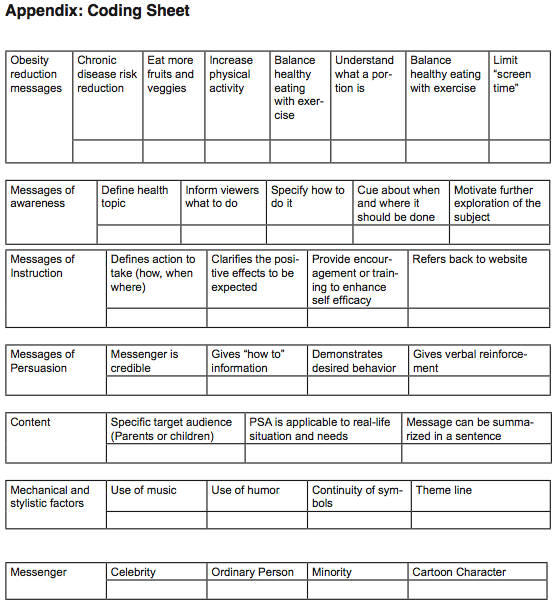From Elon Journal of Undergraduate Research in Communications VOL. 4 NO. 1Motivating Behavior Change: A Content Analysis of Public Service Announcements From the Let's Move! CampaignV . ConclusionsThis study sought to analyze television and print public service advertisements from the Let's Move! campaign with the goal of discovering how health messages are communicated and if these messages use health communication theory and practices to motivate behavior change among target audiences. Through a content analysis, this study determined that health messages are strategically communicated and used ideas from the social cognitive theory and the health belief model to target specific audiences toward making behavior changes. Findings indicated that health messages are communicated to target audiences by creating a series of separate but cohesive PSA campaigns that all had a unified theme, ultimately constructing a brand for the Let's Move! campaign similar to the brand in the VERB campaign (Snyder, 2007). By consistently displaying the Let's Move! campaign theme and logo on the PSA, it can be concluded that campaign materials are easily recognizable for any audience. The logo referred viewers back to the Let's Move! campaign website, which motivated further exploration of the subject and increased the effectiveness of the campaign message. A study by Abroms, Schiavo and Lefebvre found that by integrating new media into health campaigns, the result was more successful (2007). Because the Let's Move! campaign incorporates the web, results can be assumed to be more widespread, and help to motivate behavior change among target publics. Each PSA campaign is geared toward a specific audience such as minorities, mothers and kids, but all contain the same inherent message to eat healthy and stay active. Previous research found when health communications campaigns were specifically targeted to a group of publics, the intended audience was asked to make the requested behavior change (Marcus et al.,1998). Similar to the VERB campaign, the Let's Move! campaign featured actors from various ethnic backgrounds, body weights and ability levels so they were easily identifiable for target publics (Paravanta, 2011). Although none of the PSAs featured disabled actors, which would have furthered the ad's ability to relate to target audiences. The PSAs used real-life situations that are easily applicable to audiences of all socio-economic statuses, increasing the chances of behavior change among viewers. All PSAs from the Let's Move! campaign included messages of awareness, instruction and persuasion. According to Atkin, if a PSA contains these types of messages, individuals are motivated to make a behavior change (2001). The PSAs inform publics about obesity prevention, instruct publics by showing them how to eat healthy and stay active, and persuade publics by giving reasons why they should make this behavior change. It can be concluded that use of these messages influence target publics to a greater extent and will ultimately lead them to make the desired behavior change. Messages in the PSAs and the campaign name "Let's Move!" demand an action from viewers. The social cognitive theory and health belief model assert that in order for an individual to make a behavior change, they must have self-efficacy. The health belief model emphasizes that for individuals to have selfefficacy, they should receive cues to action including specific how-to information and verbal reinforcement (Champion & Skinner, 2008). The reinforcement in the statement "Let's Move" supports the messages verbally communicated by kids, parents and Michelle Obama in the TV PSAs. Furthermore, most of the PSAs analyzed show rather than just tell viewers exactly how to take action to prevent childhood obesity. The social learning theory, which is drawn from the social cognitive theory, states that individuals learn from observing the actions of others (Bandura, 2001). PSAs in the Let's Move! campaign use this theory to motivate behavior change by showing kids and parents taking action towards a certain obesity reduction message, furthering the viewers' motivation to make the requested behavior change. The "T-Shirts" PSA print and TV ads do not show messengers who take the requested action, it just tells in words what to do. Therefore, these PSAs can be concluded to be less effective towards motivating viewers to make the requested behavior changes. The use of concepts from the social cognitive theory and health belief model in the Let's Move! campaign PSAs indicate that health messages are drawn from communications and public health theory to make the message more effective for target audiences and yield behavior change. The health belief model states that the viewer must first recognize he or she is at risk for a condition or disease before thinking about making a behavior change (Champion & Skinner, 2008). The PSAs in the Let's Move! campaign provide how-to information to help achieve self-efficacy, but do not communicate to target audiences that they are at-risk for childhood obesity. No statistics were presented in these PSAs to increase perceived susceptibility of target audiences. Therefore, if target audiences did not think they or their kids were at-risk for childhood obesity, then they are assumed less likely to make the requested behavior change. This study cannot make any generalized conclusions about the Let's Move! campaign because a content analysis was performed only on a small portion of campaign communications. A better understanding can be gained by performing a content analysis on all PSAs released for the Let's Move! campaign. Furthermore, a broader understanding of the effectiveness of campaign messages and tactics can be achieved by employing the use of different methods such as focus groups and surveys to see if the campaign influences attitude change and any further change in behavior. AcknowledgementsThe researcher would like to thank Dr. Glen Scott for his supervision and advice throughout this process. Dr. Julie Lellis also deserves special recognition for her thoughtful assistance in helping to revise this article. ReferencesAbroms, L. C., Schiavo, R., & Lefebvre, C. (2008). New media cases in cases in public health communication & marketing: The promise and potential. Cases in Public Health Communication & Marketing, 2, 3-9. Retrieved from http://sphhs.gwu.edu/departments/pch/phcm/casesjournal/volume2/editorial/cases_2_02.pdf Atkin, C. (2001). Impact of public service advertising: Research evidence and effective strategies. Oregon State. Atkin, C. K., & Rice, R. E. (2013). Theory and principles of public communication campaigns. In Public Communication Campaigns (4th ed., pp. 3-20). Thousand Oaks, CA: SAGE Publications. Bandura, A. (2001). SOCIAL COGNITIVE THEORY: An Agentic Perspective. Annu. Rev. Psychol, 1, 26. Bandura, A. (1977). Social Learning Theory. Englewood Cliffs, NJ: Prentice Hall. Champion , V. L., & Skinner , C. S. (2008). The Health Belief Model. In Health behavior and health education (4th ed., pp. 45-64). San Francisco, CA: Jossey-Bass. Communication theory and health behavior change. (2008). In Health Behavior and Health Education: Theory, Research and Practice (4th ed., pp. 354-384). San Francisco, CA: Jossey-Bass. Faulker, G.J., Kwan, M.W., MacNeil, M., & Brownrigg, M. (2011). The long live kids campaign: Awareness of campaign messages. Journal of Health Communication, 16(5), 519-532. Retrieved from http://ehis. ebscohost.com/ehost/pdfviewer/pdfviewer?sid=fe62645f-c704-437e-ba29-3e1fc181285f%40session mgr10&vid=18&hid=5 First Lady Michelle Obama launches Let's Move: America's move to raise a healthier generation of kids. (2010, February 9). The White House. Retrieved from http://www.whitehouse.gov/the-press-office/ first-lady-michelle-obama-launches-lets-move-americas-move-raise-a-healthier-generation Huhman, M. E., Potter, L. D., Duke, J. C., Judkins, D. R., Heitzler, C. D., & Wong, F. L. (2007). Evaluation of a national physical activity intervention for children. American Journal of Preventative Medicine, 32(1). Krippendorff K. (1980) Content Analysis: An Introduction to its methodology. Sage Publications, Newbury Park. Let's Move! America's Move to Raise a Healthier Generation of Kids. Retrieved from http://www.letsmove.gov "Let's Move TV." Let's Move TV. N.p., n.d. Web. 20 Sep. 2012. Marcus, B. H., Owen, N., Forsyth, L. H., Cavill, N. A., & Fridinger, F. (1998). Physical activity interventions using mass media, print media, and information technology. American Journal of Preventative Medicine, 15(4), 362-378. Most favor government role in reducing childhood obesity. (2011). Pew Research Center for the People and the Press. Retrieved from http://pewresearch.org/pubs/1916/obesity-children-government-role-poll. Parvanta, C. F. (2011). Essentials of public health communication. Sudbury, Mass: Jones & Bartlett Learning. Riffe, D., Lacy, S., & Fico, F. (2005). Analyzing media messages: Using Quantitative content analysis in research (2nd ed.). Mahway, NJ: Lawrence Erlbaum Associates. Rippe, J. M. (1996). Overweight and health: Communications challenges and opportunities. The American Journal of Clinical Nutrition, 63(3), 470S-473S. from http://ajcn.nutrition.org/content/63/3/470S.full. pdf+html Social cognitive theory for personal and social change by enabling media. (2004). In Entertainment-Education and Social Change: History, Research, and Practice (pp. 75-96). Mahwah, New Jersey: Lawrence Erlbaum Associates. Wakefield, M. A., Loken, B., & Hornik, R. C. (2010). Use of mass media campaigns to change health behaviour. The Lancet, 376, 1261-1271. Wong, F., Huhman, M., Asbury, L., Bretthauer-Mueller, R., McCarthy, S., Londe, P., & Heitzler, C. (2004). VERB™ — A social marketing campaign to increase physical activity among youth. Preventing Chronic Disease, 1(3). Retrieved from http://www.ncbi.nlm.nih.gov/pmc/articles/PMC1253475/ Yaqubi , A. (2011). Childhood obesity in the U.S.. TuftScope: The Interdisciplinary Journal of Health, Ethics, and Policy, 10(2), 16-19. Retrieved from http://s3.amazonaws.com/tuftscope_issues/pdfs/21/ TSW2011.pdf#page=15
Suggested Reading from Inquiries Journal
Inquiries Journal provides undergraduate and graduate students around the world a platform for the wide dissemination of academic work over a range of core disciplines. Representing the work of students from hundreds of institutions around the globe, Inquiries Journal's large database of academic articles is completely free. Learn more | Blog | Submit Latest in Business & Communications |





















